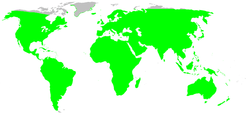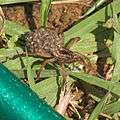Wolf spider
| Wolf spiders | |
|---|---|
 | |
| Hogna lenta | |
| Scientific classification | |
| Kingdom: | Animalia |
| Phylum: | Arthropoda |
| Subphylum: | Chelicerata |
| Class: | Arachnida |
| Order: | Araneae |
| Infraorder: | Araneomorphae |
| Superfamily: | Lycosoidea |
| Family: | Lycosidae Sundevall, 1833 |
| Genera | |
|
Acantholycosa | |
| Diversity | |
| > 100 genera, c. 2,300 species | |
 | |
Wolf spiders are members of the family Lycosidae, from the Ancient Greek word "λύκος" meaning "wolf". They are robust and agile hunters with excellent eyesight. They live mostly solitary and hunt alone. Some are opportunistic hunters pouncing upon prey as they find it or even chasing it over short distances. Some will wait for passing prey in or near the mouth of a burrow. Wolf spiders can live up to 11 years if given the correct habitat.
Wolf spiders resemble nursery web spiders (family Pisauridae), but wolf spiders carry their egg sacs by attaching them to their spinnerets (Pisauridae carry their egg sacs with their chelicerae and pedipalps). Two of the wolf spider's eight eyes are large and prominent, which distinguishes them from the nursery web spiders whose eyes are all of approximately equal size. This can also help distinguish them from grass spiders.
Description

There are many genera of wolf spider, ranging in body size (legs not included) from less than 0.4 to 1.38 inches (10 to 35 mm).[1][2] They have eight eyes arranged in three rows. The bottom row consists of four small eyes, the middle row has two very large eyes (which distinguishes them from the Pisauridae), and the top row has two medium-sized eyes. They depend on their excellent eyesight to hunt. They also possess an acute sense of touch.

Flashing a beam of light over the spider will produce eyeshine. The light from the flashlight has been reflected from the spider's eyes directly back toward its source, producing a "glow" that is easily noticed. This is also especially helpful because the wolf spiders are nocturnal and will be out hunting for food, making it easier to find them. Wolf spiders possess the third best eyesight of all spider groups, bested only by jumping spiders of the family Salticidae (who can distinguish colors) as well as the huntsman spiders.

Wolf spiders are unique in the way that they carry their eggs. The egg sac, a round silken globe, is attached to the spinnerets at the end of the abdomen, allowing the spider to carry her unborn young with her. The abdomen must be held in a raised position to keep the egg case from dragging on the ground. However, despite this handicap, they are still capable of hunting. Another aspect unique to wolf spiders is their method of infant care. Immediately after the spiderlings emerge from their protective silken case, they clamber up their mother's legs and crowd onto her abdomen.
Because they depend on camouflage for protection, they do not have the flashy appearance of some other kinds of spiders. In general their coloration is appropriate to their favorite habitat.
Hogna is the genus with the largest of the wolf spiders. Among the Hogna species in the U.S., the nearly solid dark brown H. carolinensis (Carolina wolf spider) is the largest, with a body that can be more than one inch long. It is sometimes confused with H. helluo, which is somewhat smaller and different in coloration. The underside of H. carolinensis is solid black, but the underside of H. helluo is variegated and has reds, oranges, and yellows with shades of black.

Some members of the Lycosidae, such as H. carolinensis, make deep tubular burrows in which they lurk much of the time. Others, such as H. helluo, seek shelter under rocks and other shelters as nature may provide. They may wander from place to place, and are therefore more likely to be the ones attracted into human habitation when the weather starts to turn colder in autumn.
There are many smaller genera of wolf spiders such as those found in the United Kingdom. They live in pastures and fields and feed on smaller prey, playing an important role in natural population control that keeps insect numbers in the wolf spiders' vicinity within acceptable levels.
Venom
Wolf spiders will inject venom if continually provoked. Symptoms of their venomous bite include swelling, mild pain, and itching. In the past, necrotic bites have been attributed to some South American species, but further investigation has indicated that those problems that did occur were probably actually due to bites by members of other genera.[3] Australian wolf spiders have also been associated with necrotic wounds, but careful study has likewise shown them not to produce such results.[4]
Habitats
Wolf spiders can be found in a wide range of habitats both coastal and inland. These include shrublands, woodland, wet coastal forest, alpine meadows, suburban gardens, and homes. Spiderlings disperse aerially and consequently wolf spiders have wide distributions. Although some species have very specific microhabitat needs (such as stream-side gravel beds or montane herb-fields) most are wanderers without permanent homes. Some build burrows which can be left open or have a trapdoor (depending on species). Arid zone species construct turrets or plug their holes with leaves and pebbles during the rainy season to protect themselves from flood waters.
Honoraria
The Carolina wolf spider (H. carolinensis) is the official state spider of South Carolina, designated as such in 2000. South Carolina is the only U.S. state that recognizes a state spider.[5]
Gallery
 Wolf spider carrying her egg sac
Wolf spider carrying her egg sac Wolf spider with offspring (Germany).
Wolf spider with offspring (Germany).- Wolf spider carrying offspring, Australia.
 Wolf spider carrying her young.
Wolf spider carrying her young. Burrowing wolf spider defending its egg sac.
Burrowing wolf spider defending its egg sac..jpg) Wolf spider carrying egg sac
Wolf spider carrying egg sac Wolf Spider in Maricopa City, Arizona, roughly 25 mm (0.98 in) while legs were retracted
Wolf Spider in Maricopa City, Arizona, roughly 25 mm (0.98 in) while legs were retracted- Large Wolf Spider with young in Michigan.
 Large Carolina Wolf Spider; Hogna carolinensis
Large Carolina Wolf Spider; Hogna carolinensis Wolf Spider in Delray Beach, FL.
Wolf Spider in Delray Beach, FL.- Wolf spider (Rabidosa sp.) carrying egg sac under abdomen for protection
 Wolf spider, Anoteropsis aerescens, New Zealand
Wolf spider, Anoteropsis aerescens, New Zealand Wolf spider, Greenwood, Missouri
Wolf spider, Greenwood, Missouri- Wolf spider from central Florida
 Wolf spider preying on a grasshopper, Melisochori, Greece
Wolf spider preying on a grasshopper, Melisochori, Greece Wolf spider (Rabidosa rabida) next to US quarters indicating its body length of about 1 in (25 mm), Prosper, TX
Wolf spider (Rabidosa rabida) next to US quarters indicating its body length of about 1 in (25 mm), Prosper, TX
Footnotes
- ↑ "Wolf Spiders: Lycosidae Sundevall 1833". Australasian Arachnology Society. Retrieved 2 October 2008.
- ↑ Spiders of North America, D. Ubick et al., p. 164
- ↑ Ribeiro, L. A.; Jorge, M. T.; Piesco, R. V.; Nishioka, S. A. (1990). "Wolf spider bites in São Paulo, Brazil: A clinical and epidemiological study of 515 cases". Toxicon. 28 (6): 715–717. doi:10.1016/0041-0101(90)90260-E.
- ↑ Isbister, Geoffrey K.; Framenau, Volker W. (2004). "Australian Wolf Spider Bites (Lycosidae): Clinical Effects and Influence of Species on Bite Circumstances". Clinical Toxicology. 42 (2): 153–161. doi:10.1081/CLT-120030941.
- ↑ "Carolina Wolf Spider State Spider". statesymbolsusa.org.
South Carolina designated the Carolina wolf spider (Hogna carolinensis) as the official state spider in 2000 due to the efforts of Skyler B. Hutto, a third grade student at Sheridan Elementary School in Orangeburg, SC.
See also
- List of spiders associated with cutaneous reactions
- List of Lycosidae genera
- List of Lycosidae species
References
- Platnick, Norman I. (2008): The world spider catalog, version 8.5. American Museum of Natural History.
External links
| Wikimedia Commons has media related to Lycosidae. |
| Wikispecies has information related to: Lycosidae |
- Wolf Spider Fact Sheet highlights prevention tips as well as information on habits, habitat and health threats
- Wolf Spider Website Comprehensive site with info on a range of subject, from habitat, to life-cycle, to myths and facts about bites. Includes videos of Wolf Spiders in the wild and captivity (Accessed September 7, 2015)